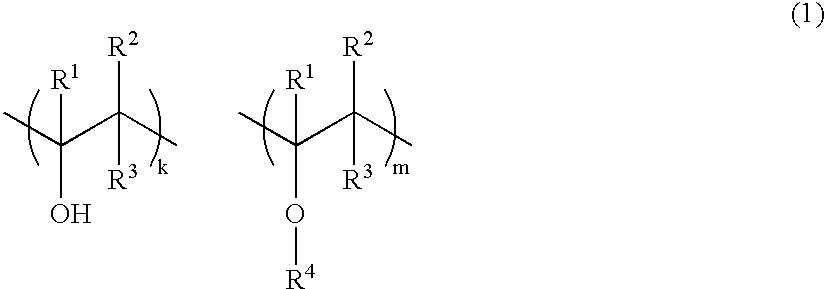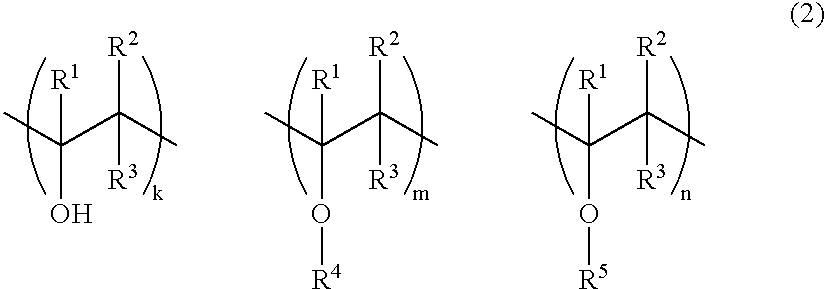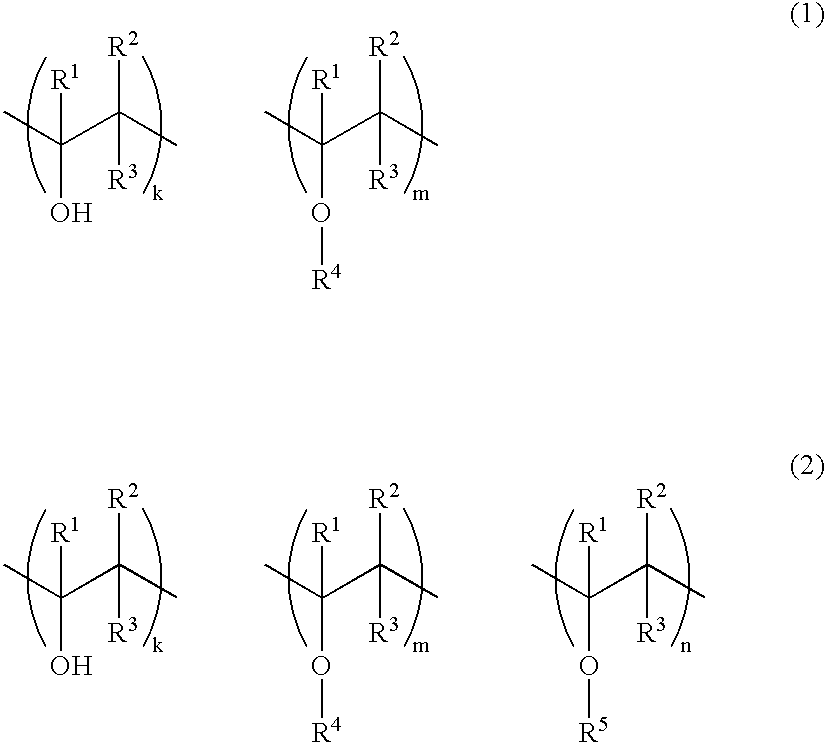Polymers, chemical amplification resist compositions and patterning process
a chemical amplification and composition technology, applied in the field of polymers, can solve the problems of inability to use resist base resins, more difficulty in ensuring transparency, etc., and achieve the effects of excellent sensitivity, resolution and plasma etching resistance, outstanding thermal stability and reproducibility
- Summary
- Abstract
- Description
- Claims
- Application Information
AI Technical Summary
Benefits of technology
Problems solved by technology
Method used
Image
Examples
synthesis example 1
Synthesis of poly(trifluoromethyl trifluorovinyl ether)
In a nitrogen stream, a 1-liter autoclave was charged with 300 ml of deaerated toluene and 2 g of initiator AIBN. While the autoclave was kept at a temperature of 78.degree. C., 50 g of trifluoromethyl trifluorovinyl ether was blown into the solution. The reaction solution was cooled down to room temperature and heated again to 60.degree. C., at which polymerization was effected for 24 hours.
In order to work up the polymer, the reaction mixture was poured into methanol whereupon the polymer precipitated. It was separated and dried, obtaining 40 g of a white polymer, poly(trifluoromethyl trifluorovinyl ether). This polymer was found to have a weight average molecular weight (Mw) of 15,500 g / mol as measured by the light scattering method and a dispersity (Mw / Mn) of 1.60 as determined from the GPC elution curve.
synthesis example 2
Synthesis of poly(trifluorovinyl alcohol)
A 1-liter flask was charged with 40 g of the poly(trifluoromethyl trifluorovinyl ether) obtained in Synthesis Example 1, 72 g of sodium iodide and 300 ml of acetonitrile. With stirring at room temperature, 53 g of chlorotrimethylsilane from a dropping funnel was added dropwise in such a controlled manner that the reaction temperature might not exceed 30.degree. C. The reaction mixture was then heated at 60.degree. C. and ripened for 24 hours.
Next, under ice cooling, 100 g of pure water was added dropwise to the reaction solution, which was heated at 60.degree. C. and ripened for 10 hours. After decoloration with an aqueous sodium hydrogensulfite solution, the reaction solution was transferred to a separatory funnel. The upper layer was taken out, and 200 g of ethyl acetate and 100 g of toluene were added thereto. The polymer layer was washed twice with 150 g of water. The polymer solution was transferred to a dropping funnel, from which the s...
synthesis example 3
Tetrahydropyranylation of poly(trifluorovinyl alcohol)
A 300-ml flask was charged with 20 g of the poly(trifluorovinyl alcohol) obtained in Synthesis Example 2, 0.6 g of trifluoromethanesulfonic acid and 100 ml of THF. With stirring at room temperature, 4.0 g of 3,4-dihydro-2H-pyran was added dropwise from a dropping funnel. The reaction mixture was ripened at room temperature for one hour.
Triethylamine was added to the reaction system to terminate reaction, and the solvent was distilled off under vacuum. The resulting crude polymer was dissolved in 40 g of acetone, which was poured into 5 liters of pure water with 20 g of acetic acid dissolved therein, whereupon the polymer precipitated. The procedure of dissolving the polymer in 40 g of acetone and pouring it into 5 liters of pure water for precipitation was repeated twice, following which the polymer was separated and dried. There was obtained 15 g of a white polymer, 20% tetrahydropyranylated poly(trifluorovinyl alcohol). This po...
PUM
| Property | Measurement | Unit |
|---|---|---|
| Nanoscale particle size | aaaaa | aaaaa |
| Length | aaaaa | aaaaa |
| Length | aaaaa | aaaaa |
Abstract
Description
Claims
Application Information
 Login to View More
Login to View More - R&D
- Intellectual Property
- Life Sciences
- Materials
- Tech Scout
- Unparalleled Data Quality
- Higher Quality Content
- 60% Fewer Hallucinations
Browse by: Latest US Patents, China's latest patents, Technical Efficacy Thesaurus, Application Domain, Technology Topic, Popular Technical Reports.
© 2025 PatSnap. All rights reserved.Legal|Privacy policy|Modern Slavery Act Transparency Statement|Sitemap|About US| Contact US: help@patsnap.com



